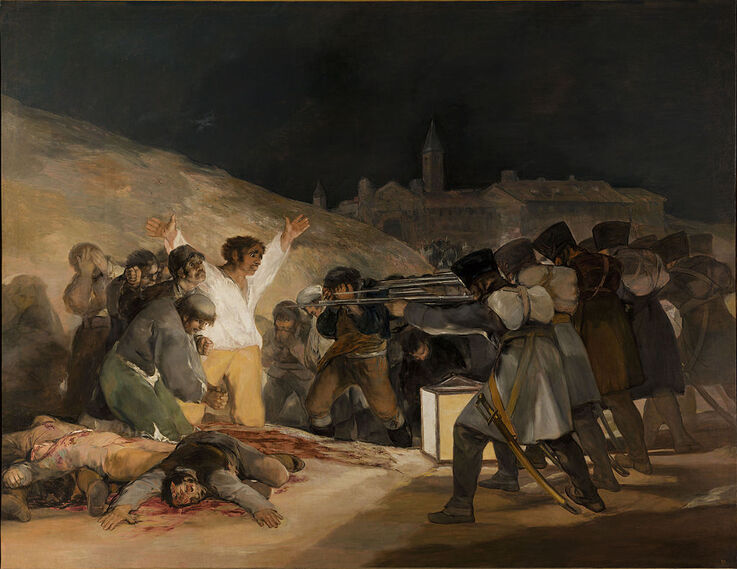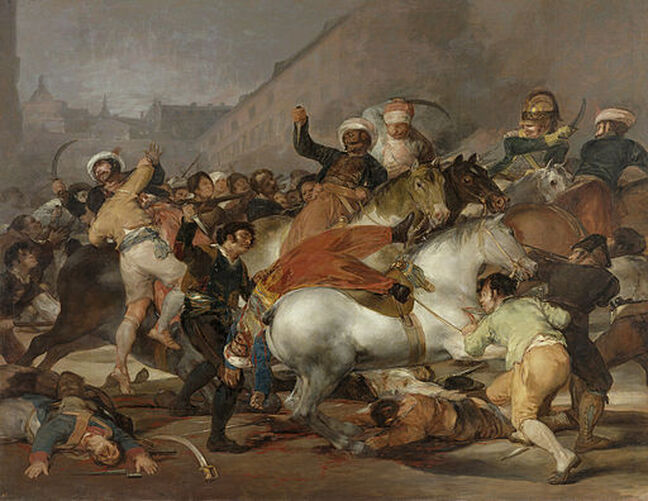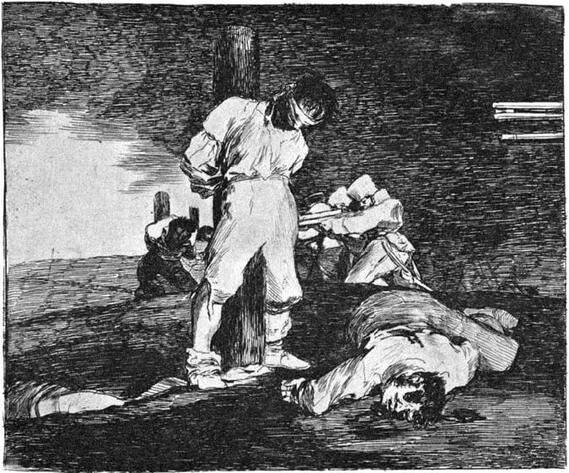|
Where? Room 64 of the Prado Museum
When? 1814 Commissioned by: The Spanish government What do you see? A group of French soldiers on the right point their rifles at a Spanish peasant dressed in white. The French firing squad is about to execute the peasant who stands against a hill with his arms raised like a Christ figure in surrender. At his feet are some of his comrades who have been slaughtered by the firing squad, their blood still running on the dirt. And surrounding them are other people that are next in line to face the firing squad. Some of them cover their eyes as they do not want to witness the gruel scene in front of them. Among the people surrounding the man in white is also a bold-headed monk. He is directly to the left (from our point of view) of the man in the center, and he has his hands clasped in prayer, avoiding the eyes of the soldiers. Backstory: This painting is a commemoration of a true historical event, Napoleon’s French army invading Spain. This painting shows a particular scene that occurred on May 3, 1808, when the French army decided to execute Spanish citizens that rebelled against them. Francisco Goya was deeply affected by this series of events and decided to create this painting to show the injustice of the French army’s actions. Goya has dramatized the moment. The square lantern in the center pours bright light onto the rebels on the left and the man dressed in white. Goya gives him a Christ-like aura with his arms raised in golden light. The man is made into a martyr while the French soldiers are left anonymous and thus soulless. May 2, 1808: This was the day that many citizens of Madrid rebelled against the French occupation. Crowds assembled around the Royal Palace of Madrid protesting French occupation. The French soldiers opened fire on the crowds, triggering street fights and rebellion in other parts of the city. The French armed forces outnumbered the Spanish citizens. Goya captured the events on this day in his painting The Second of May 1808, which is also in the Prado Museum. The painting depicts the Mamelukes (Napoleon’s Turkish soldiers) in a street fight with Spanish rebels. When the conflict had subsided, hundreds of Spanish citizens had died. Many survivors were taken prisoner for execution the next day.
May 3, 1808: The day after the Spanish rebelled against the French army, the rebels were executed by French firing squads. Many surviving Spanish rebels were gathered and shot in several locations in Madrid. Supposedly, most of the executed rebels were peasants, artisans, and beggars. About one hundred deaths by firing squads were reported.
Who is Goya? Francisco Goya was born in 1746 in Fuendetodos in the Northeast of Spain and died in 1828 in Bordeaux, France. He studied drawing and painting in Zaragoza and joined the studio of José Luzán. Later, he studied under Francisco Bayeu Subías who led him to work on decorations for the royal palace. Goya married Subías’s sister and traveled to Italy after failing in two drawing competitions at the Real Academia des Bellas Artes in San Fernando. Eventually, Goya was appointed painter to the Royal Tapestry Factory in Madrid. Goya's work was reminiscent of Rococo art and focused on day-to-day events. As his work gained more attention, Goya rose to the position of court painter to King Charles III and Charles IV. Around this time, he began to travel Andalusia to study realism. When he returned from his trip, he had fallen ill and gone deaf. Before the decline of his health, much of Goya’s work had been cheerful and warm. After losing his hearing, Goya’s work became dark and filled with monsters, darkness, and ghosts. Witches’ Sabbath in the Prado Museum is an example of such a dark work. It is part of his series of fourteen Black Paintings.
Fun fact: Before painting The Third of May 1808, Goya had worked on a series called The Disasters of War. These gruesome prints showed the violence, gore, and fear that comes from war. Without taking a side in the conflict, Goya expressed great anti-war sentiment. The prints were not published until decades later.
Written by Sabrina Tian
References:
2 Comments
Marie Well
7/2/2024 05:11:02 am
I love your painting analysis within their historical context. Excellent work! Thank you.
Reply
Eelco Kappe
7/5/2024 01:29:43 pm
Thank you!
Reply
Leave a Reply. |
Categories
All
|
- Home
- Blog
-
Museums
- Alte Pinakothek
- Art Institute of Chicago
- Baltimore Museum of Art
- Barber Institute of Fine Arts
- Bargello
- Barnes Foundation
- British Museum
- Church of Sant’Anastasia
- Cleveland Museum of Art
- Courtauld Institute of Art
- Detroit Institute of Arts
- Frans Hals Museum
- Galleria Borghese
- Gallerie dell'Accademia
- Getty Museum
- Guggenheim
- Hermitage Museum
- Kunsthistorisches Museum
- Kunstmuseum Basel
- Legion of Honor Museum
- Louvre
- Mauritshuis
- Metropolitan Museum of Art
- Musee d’Orsay
- Museum of Fine Arts in Boston
- Museum of Modern Art
- National Gallery in London
- National Gallery of Art
- National Museum in Poznań
- Norton Simon Museum
- Ny Carlsberg Glyptotek
- Palace of Versailles
- Palazzo Pitti
- Palazzo Vecchio
- Petit Palais
- Philadelphia Museum of Art
- Prado
- Pushkin Museum
- Ravenna Art Museum
- Rijksmuseum
- San Diego Museum of Art
- Santa Maria delle Grazie
- St. Peter's Basilica
- Städel Museum
- Statens Museum for Kunst
- Tate Britain
- Tate Modern
- Timken Museum of Art
- Uffizi
- Vatican Museums
- Wallace Collection
-
Artists
- Altdorfer
- Anguissola
- Berlin Painter
- Bosch
- Botticelli
- Boucher
- Bronzino
- Bruegel the Elder
- Brunelleschi
- Cabanel
- Caillebotte
- Canova
- Caravaggio
- Carpeaux
- Cezanne
- Cimabue
- David
- Degas
- Delacroix
- De Maria
- Donatello
- El Greco
- Fontana
- Fra Angelico
- Fragonard
- Gauguin
- Gentileschi
- Gericault
- Gonzalez-Torres
- Goya
- Hals
- Hogarth
- Hokusai
- Ingres
- Leonardo da Vinci
- Lippi, Filippo
- Longhi, Barbara
- Lorrain
- Makovsky
- Manet
- Massys
- Matisse
- Merian
- Michelangelo
- Mochi
- Modigliani
- Monet
- Panini
- Parmigianino
- Perugino
- Picasso
- Pisanello
- Raphael
- Rembrandt
- Renoir
- Reynolds
- Rivera
- Rodin
- Rubens
- Scultori
- Seurat
- Steen
- Tintoretto
- Titian
- Toulouse-Lautrec
- Turner
- Uccello
- Van der Weyden
- Van Dyck
- Van Eyck
- Van Gogh
- Van Hemessen
- Vasari
- Velazquez
- Vermeer
- Veronese
- Vigée Le Brun
-
Locations
- Books
- About Us




